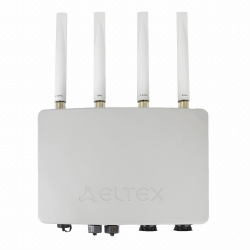This resource is no longer supported: some of the new hardware is not published here, and some of the documentation and software are outdated.
For the most up-to-date information, please use the new website eltex-co.com
Wireless access point WOP-30LI
- Dual band access point
- Support for 802.11ax
- Radio interface with MU-MIMO 2×2
- 2 × 1GE and 2 × SFP (1G) ports
- PoE+ (IEEE 802.3at-2009) and 12–56 V DC power supply
- Up-to-date authentication and encryption means
Industrial access point
WOP-30LI is a next-generation industrial access point of Wi-Fi 6 (IEEE 802.11ax) that provides a high-speed and secure wireless network. Due to built-in 2 × 1GE and 2 × SFP (1G) ports, WOP-30LI allows connecting other devices and cascading multiple access points into one network. The robust sealed housing of WOP-30LI with IP67 ingress protection is ideal for installing the device in extreme industrial facilities and open areas (factories, quarries, production buildings, large industrial complexes, warehouses, etc.)
Scalability
The WOP-30LI wireless access point is the latest flexible solution that allows changing the network coverage area, thereby increasing the number of mobile devices served. The high performance of the hardware platform, scalability and intuitive interface make it easy and quick to deploy a wireless IT infrastructure.
Wireless connection
Due to support for IEEE 802.11ax standard the WOP-30LI access point provides 574 Mbps (2.4 GHz) + 1201 Mbps (5 GHz) data rates. Using the MU-MIMO technology and omnidirectional antennas makes WOP-30LI a universal solution for organizing public networks.
Security
To ensure a secure connection, the modern WPA3 authentication and encryption technologies are supported. The new generation access points meet the highest security and compatibility requirements for earlier versions of the 802.11 standard.
Performance
The high-performance processors are used in the devices in order to provide reliability and high data processing rates.
Power supply
WOP-30LI supports power supply variability, so the access point is powered either through a DC connector from a DC power supply or via an Ethernet cable (PoE+). The ability to choose a power source expands the application possibilities of the device.
Interfaces
- 2 × 10/100/1000BASE-T ports (RJ-45), one of the ports with PoE+ support
- 1 × 100/1000BASE-X port (SFP)
- 1 × 1000BASE-X port (SFP)
- Wi-Fi 2.4 GHz IEEE 802.11b/g/n/ax
- Wi-Fi 5 GHz IEEE 802.11a/n/ac/ax
- 4 × N type connectors (female) for external antennas (Omni, sector, panel and etc.)
WLAN capabilities
- Support for IEEE 802.11a/b/g/n/ac/ax
- Support for IEEE 802.11r/k/v roaming
- Data aggregation, including A-MPDU (Tx/Rx) and A-MSDU (Rx)
- WMM-based packet priorities and planning
- Dynamic frequency selection (DFS)
- Support for hidden SSID
- 14 virtual access points
- Third-party access points detection
- Spectrum analyzer
- Support for wireless bridges (WDS)
- APSD
Network features
- Automatic speed negotiation, duplex mode negotiation and MDI-MDI-X switch-over
- VLAN support (Access, Trunk, General)
- DHCP client
- GRE
- Transmission of subscriber traffic outside of tunnels
- ACL
- NTP
- Syslog
- IPv6
- LLDP
QoS functions
- Packet priorities and planning based on profiles
- Bandwidth limiting for each SSID
Configuration
- Remote management Telnet, SSH
- CLI
- NETCONF
- Web interface
- SNMP
Security
- Centralized authorization via RADIUS server (802.1X WPA/WPA2 WPA3 Enterprise)
- WPA/WPA2/WPA3/OWE encryption
- Captive Portal
- Authorization via RADIUS server when logging into the device
Wireless interface specifications
- Frequency range: 2400–2483.5 MHz; 5150–5350 MHz, 5470–5850 MHz
- BPSK, QPSK, 16QAM, 64QAM, 256QAM, 1024QAM modulations
- Support for MU-MIMO 2×2
- Support for OFDMA
- Bandwidth:
- 20, 40 MHz for 2.4 GHz;
- 20, 40 and 80 MHz for 5 GHz
Operating channels1
- 802.11b/g/n/ax: 1–13 (2401–2483 MHz)
- 802.11a/n/ac/ax: 36–64 (5170–5330 MHz), 100–144 (5490–5730 MHz), 149–165 (5735–5835 MHz)
Data rate2
- 2.4 GHz, 802.11ax: 574 Mbps
- 5 GHz, 802.11ax: 1201 Mbps
Maximum power of the transmitter1
- 2.4 GHz: 20 dBm
- 5 GHz: 20 dBm
Receiver sensitivity
-
2.4 GHz: up to -93 dBm
-
5 GHz: up to -94 dBm
- Power consumption: no more than 17.5 W
- 128 MB SPI-NAND Flash
- 256 MB DDR3 RAM
- Power supply:
- PoE+ 48 V/56 V (IEEE 802.3at-2009)
- DC 12–56 V
- Operating temperature: from -45 to +65 °C
- Ingress protection: IP67
- Dimensions (W × H × D):
- 308 × 253 × 91 mm
- 308 × 367 × 91 mm (with cable gland)
- Weight: 3.2 kg
- Pole/wall mount
1The number of channels and the value of the maximum output power will vary according to the rules of radio frequency regulation in your country.
2The maximum wireless data rate is defined according to IEEE 802.11 standard. The real bandwidth can be different. Conditions of the network, environment, the amount of traffic, building materials and constructions and network service data can decrease the real bandwidth. The environment can influence on the network coverage range.
During the warranty period the manufacturer ensures technical support and free-of-charge repair at the Enterprise which is situated in Novosibirsk.
As part of the warranty service, technical support is provided on the first-in first-out principle.
The priority support packages of 8/5 and 27/7 types are subjects to additional charges.








